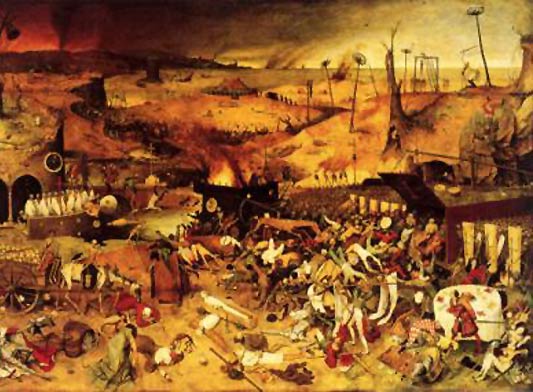PANDEMICS
Epidemics occur when an infectious disease spreads in a local population, lasting longer and reaching people in a wider geographical area. When that disease reaches worldwide proportions, it is considered a pandemic. Several factors determine whether an outbreak will explode into an epidemic or pandemic: the ease with which a microbe moves from person to person, and the behaviour of individuals and societies.
On the global level, different populations interact through travel, trade, and war, all opportunities for microbes to reach new areas. Rapidly growing cities also allow microbes to infect large groups of people. Of course, in many situations, individual and communal behaviour also contribute to the spread of disease.
Pandemics, such as the 14th-century plague known as the Black Death, have been occurring for centuries. The Black Death devastated populations throughout Asia and Europe.
Several factors contribute to the global spread of an infectious disease. The principal factor depends on how easily the disease-causing microbe is transmitted from person to person. For example, the tuberculosis microbe moves through a population much more slowly than the influenza microbe.
Some microbes live inside animals, such as mosquitoes or mice, during part of their life cycle. The habitat and life cycle of that animal can limit or extend the range of the microbe.
Human behaviour and public health conditions are also important factors. Reusing needles for injecting vaccines or drugs increases risk of infection, as does using water from a polluted source.
Warfare has long been linked to disease. In fact, infectious diseases sometimes kill more soldiers than do battle wounds. Infected soldiers allow microbes to enter new ecosystems and infect civilians, sometimes with disastrous results. Soldiers may also pick up infections abroad and carry them back home.
During a war, civilian populations are equally at risk from the breakdown of infrastructure and public health systems, and the scarcity of medicine. People are often forced from their homes into crowded, unsanitary refugee camps.
Warfare also destroys ecosystems. Animals carrying disease-causing microbes may multiply in such altered environments.
Throughout history, travellers moving about the world for work, adventure, or resettlement have spread disease. Microbes that infest insects and rodents -on ancient merchant ships to modern jet planes-have also spread disease. And other disease-causing microbes can lodge in the huge quantity of foods, and other trade goods that are always moving across the globe.
Today, few places in the world are truly isolated: people and goods are transported more easily, rapidly, and frequently than ever before.
Cities bring many people into close contact, making it easier for disease-carrying microbes to circulate, especially among poor people crowded together in unsanitary conditions. And in rapidly growing cities, particularly those in developing countries, public health programs often lack the resources to reach the people who need the most help. Lack of access to vaccinations, medicines, and public health information all contribute to the spread of microbe-caused diseases
Human behaviour, combined with changes in weather patterns, contributes to the spread of infectious diseases. Both can produce conditions that lead to increases in disease-causing microbes and the animals that carry then.
